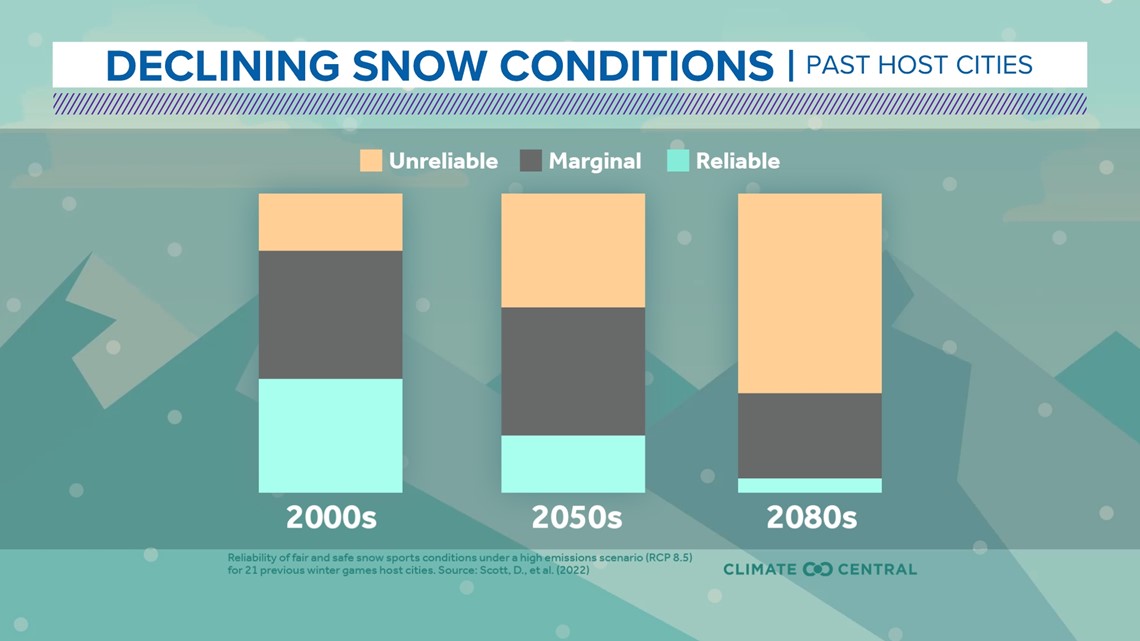GRAND RAPIDS, Mich. — While the Winter Olympics kicked off Friday in Beijing with less fanfare than usual thanks to the continuing COVID-19 pandemic, these games are already notable for another as of yet unprecedented reason.
This year's games will be the first one in which the outdoor events will rely on almost 100% artificial snow.
While the lack of snowfall at these games is not unexpected, in fact International Olympic Committee (IOC) knew well ahead of time that the proposed locations would primarily rely on artificial snow, it does sound a clear warning. That warning being that the viability of the winter games is being threatened and that the number of cities that could reliably host the winter games is going to shrink drastically if trends continue as they have been.
Several studies have been done on current climate change trends and previous Winter Olympic host cities and they have all indicated that only a fraction of the previously hosting cities would be reliable hosts going into the future. A study from Scott et al. (2014) determined that by 2050 only 10 of the 19 previous host cities would be considered to have reliable enough winter weather to host a the winter games, with the number dropping to just 6 by 2080.
Using the same criteria, Beijing would be considered unreliable by 2050 as well.


According to data from Berkeley Earth provided through Climate Central, looking at the past host cities temperatures have warmed by 4.8 °F on average since 1950. Beijing has warmed 8.9 °F during this same time period.
With these trends in mind, it is no wonder why the need for artificial snow is only expected to go up in the years to come, but this fix is not a panacea for winter sports. According to information gathered by the Sport Ecology Group, the artificial snow at the 2022 Winter Olympics will consume 49 million gallons of water, require hundreds of snow generating devices, and cost almost 3.6 million dollars in resources and energy to generate.
Artificial snow also impacts the local environment as it contains more water in the form of ice than natural snow, about three times what is natural. This can cause artificial snow to stick around longer into the warming season and also increase runoff when it does eventually melt.
Athletes aren't all keen on this artificial snowfall either. We spoke with Dr. Walker Ross, an Assistant Professor of Sport Business Management at Florida Southern College who said "from an athletic standpoint, most of the athletes have been complaining about the quality of the snow because artificial snow is so much harder than natural snow, it hurts to fall on." He added, "it just rides differently. So it's you know, it's still skiing, it's still snowboarding, they're still the same sport, but it's as if the playing field is a little bit different at this point."
If current trends continue, winter sports are going to become harder to host and be available for less people to participate in, as access to them will require money and resources to travel to viable locations. This will impact the Winter Olympics in terms of both talent for the games, but also in public interest for the sports as they become something only those at the higher levels of society even have the option to take part in.
Looking toward the future Dr. Ross said, "If I'm the International Olympic Committee, I would be quite concerned about this moving forward in terms of where we can host our event, and if I'm the federation's or the sports themselves, I'm concerned because that means that it might not be possible to participate in my sport in the future." He conclude with, "if trends continue the way that they have been, they're going to be in some danger with respect to winter sports."
You can find the full study from the Sport Ecology Group LINKED HERE and you can see my full interview with Dr. Ross in the YouTube video below.
-- Meteorologist Michael Behrens
Follow me on social media! Facebook Meteorologist Michael Behrens, Twitter @MikeBehrensWX, and Instagram @MikeBehrensWX.
Email me at: MBehrens@13OnYourSide.com
Have a 30-second video or still photo to share? We'd love to share it with everyone! Email your image to Weather@13OnYourSide.com or post it to our 13OnYourSide Facebook Page.
►Make it easy to keep up to date with more stories like this. Download the 13 ON YOUR SIDE app now.
Have a news tip? Email news@13onyourside.com, visit our Facebook page or Twitter. Subscribe to our YouTube channel.

